JUNE KEY FIGURES
 |  | Credit market outstandings at end
| Demand for credit during
| Other changes during
| Credit market outstandings at end
|
 |  | Mar Qtr 2004 | Jun Qtr 2004 | Jun Qtr 2004 | Jun Qtr 2004 |
 |  | $b | $b | $b | $b |
|
| Non-financial corporations |  |  |  |  |
 | Private | 1,089.0 | 14.8 | 20.5 | 1,124.3 |
 | National public | 43.0 | 0.2 | 4.7 | 48.0 |
 | State and local public | 38.9 | -1.3 | 0.2 | 37.8 |
| General government |  |  |  |  |
 | National | 61.1 | 1.7 | -1.0 | 61.8 |
 | State and local | 36.4 | -0.8 | 0.0 | 35.6 |
| Households | 763.0 | 31.3 | 0.0 | 794.4 |
| Total | 2,031.4 | 46.0 | 24.4 | 2,101.8 |
|
Total demand for credit
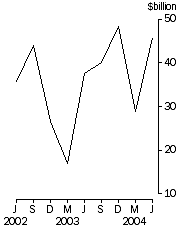
| Credit market oustandings
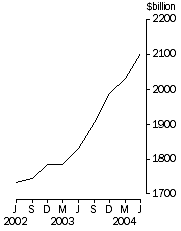
|
JUNE KEY POINTS
SUMMARY
- Total demand for credit by the non-financial domestic sectors for the June quarter 2004 was $46.0b, an increase of $17.1b on the previous quarter. Increased raisings by private non-financial corporations (up $11.2b) and increased borrowing by households (up $6.6b) were the main contributors to the rise.
NON-FINANCIAL CORPORATIONS
- Private non-financial corporations raised a net $14.8b with share raisings of $5.8b (up from $4.3b) and loans of $7.1b.
- National public non-financial corporations raised $0.2b and state and local public non-financial corporations repaid a net $1.3b during the quarter.
GENERAL GOVERNMENT
- National general government raised a net $1.7b during the quarter mainly by issuing bonds. State and local general government repaid a net $0.8b through loan repayments.
HOUSEHOLDS
- Households raised a net $31.3b during the quarter, an increase of $6.6b on the previous quarter, to bring their outstandings to $794.4b at the end of June 2004. Households borrowed $24.5b from banks (of which $10.1b was for owner occupied and $8.3b for investment housing), an increase of $13.6b from the previous quarter. Borrowing from financial intermediaries n.e.c. was $4.2b during the quarter (mainly for housing), a decrease of $8.1b from the previous quarter.
NOTES
SYMBOLS AND OTHER USAGES
b (billion)
billion (one thousand million)
trillion (one million million i.e. one thousand billion)
n.y.a. not yet available
CHANGES TO THIS ISSUE
For the print version there are a number of small presentation changes, the most significant of which are in table 37 of bonds issued in Australia by non-residents (kangaroo bonds), see also revisions this issue below.
Users of the spreadsheet release are alerted to a number of new series that have emerged as a result of changes and revisions. The major change are in tables 37 and 45 for bonds issued in Australia by non-residents.
SIGNIFICANT EVENTS
Response rates for some June reference quarter 2004 surveys were lower than expected following an increase in merger activity and the stage of the corporate reporting cycle. This has resulted in higher than normal imputation in some series, particularly with unit trusts.
There were no privatisations or other significant structural changes impacting the aggregates.
National general government final budget outcome was received too late for inclusion in this issue and will be incorporated next quarter.
REVISIONS IN THIS ISSUE
The data incorporate the results of quality assurance work undertaken with providers and other revisions back to September quarter 2000.
There have been 15 quarters of revisions applied in the Survey of International Investment, as reflected in the Balance of Payments and International Investment Position, June quarter 2004. The major impacts are a reduction in assets invested offshore by fund managers and improved coverage of bonds issued in Australia by non-residents (kangaroo bonds). As foreshadowed last issue, table 37 has been changed to present kangaroo bond data. The table now shows issues in Australia by non-residents as well as holdings by residents in bonds issued by non-residents offshore. The take up by non-residents of issues in Australia by non-residents is accounted for in this table.
Also incorporated are the results of revised methods for calculating transactions in units issued by unit trusts.
INQUIRIES
For further information about these and related statistics, contact the National Information and Referral Service on 1300 135 070 or Derick Cullen on Canberra (02) 6252 6244.
ANALYSIS AND COMMENTS SECTORAL SUMMARY
INTERSECTORAL FINANCIAL FLOWS
During June Quarter 2004
Significant flows during the June quarter 2004 were the net $9.3b borrowed by households from financial corporations and the net $2.9b borrowed by non-financial corporations from financial corporations. General government repaid a net $2.2b to financial corporations and borrowed a net $2.1b from rest of world.
During Year 2003-2004
Significant flows during the year ended June 2004 were the net $46.9b borrowed by households from financial corporations; the net $35.7b borrowed by financial corporations from rest of world; the net $12.9b raised by non-financial corporations from financial corporations, and the net $16.7b repaid by general government to financial corporations.
ANALYSIS AND COMMENTS MARKET SUMMARY
FINANCIAL MARKET ANALYSIS
 | Outstanding at end
| Trans- actions during
| Other changes during
| Outstanding at end
|
 | Mar Qtr 2004 | Jun Qtr 2004 | Jun Qtr 2004 | Jun Qtr 2004 |
| Selected Financial Instruments | $b | $b | $b | $b |
|
| Currency and deposits | 748.6 | 24.9 | 5.4 | 778.9 |
| Short term debt securities | 336.7 | -3.2 | 2.1 | 335.6 |
| Long term debt securities | 564.3 | 33.9 | 9.2 | 607.4 |
| Derivatives | 157.0 | -23.9 | 12.7 | 145.8 |
| Loans and placements | 1,574.8 | 42.2 | 5.5 | 1,622.4 |
| Listed shares | 827.9 | 7.5 | 29.2 | 864.5 |
| Unlisted shares | 818.3 | 8.9 | 21.7 | 848.8 |
| Reserves of life offices and pension funds | 609.8 | 14.1 | 10.3 | 634.2 |
| General insurance prepayments and reserves | 58.2 | -0.2 | 0.0 | 58.0 |
|
Deposit liabilities increased to $778.9b at the end of June 2004, following net transactions of $24.9b during the quarter, compared with transactions of $2.5b in the previous quarter. Transactions in bank deposits were $20.3b, up from the $8.7b recorded during the March quarter.
Short term security liabilities decreased to $335.6b at the end of June 2004, with net redemptions of $3.2b and a valuation increase of $2.1b during the quarter. $5.3b in one name paper was redeemed, of which offshore redemptions accounted for $6.0b while $0.7b was issued in Australia. Bills of exchange on issue increased by $2.1b.
Total bond liabilities increased to $607.4b with net issues of $33.9b during the quarter. Banks issued a net $18.1b, of which $15.4b was issued offshore and $2.7b was issued in Australia. Financial intermediaries n.e.c issued $6.0b, of which $2.2b was issued in Australia and $3.7b was issued offshore. Issue in the Australian market by non-residents was $2.6b (down $5.7b), of which non-residents purchased $0.8b.
The value of derivative contracts on issue at 30 June 2004 decreased by a net $11.2b to $145.8b. Components of the decrease were net settlements of $23.9b and valuation changes of $12.7b.
Loan liabilities rose to $1,622.4b at the end of June 2004 following net transactions of $42.2b during the quarter. Borrowing by households continued to be strong, raising $30.4b, while pension funds borrowed $11.5b and banks repaid a net $5.6b.
The listed share market increased by $36.6b to $864.5b at the end of June 2004, with net issues of $7.5b and valuation increases of $29.2b. Private non-financial corporations had net issues of $6.7b and financial intermediaries n.e.c had issues of $0.8b.
The value of the unlisted share market increased by $30.5b to $848.8b. There were net issues of $8.9b, with issues by financial intermediaries n.e.c of $1.4b, and Australian investment overseas of $6.5b. Valuation increases amounted to $21.7b.
At the end of June 2004 the reserves of life offices and pension funds were $634.2b following net transactions during the quarter of $14.1b and valuation increases of $10.3b. General insurance prepayments and reserves were $58.0b.
SECTORAL ANALYSIS
NON-FINANCIAL CORPORATIONS
Summary
Private non-financial corporations raised a net $14.8b (excluding derivatives and accounts payable) during the June quarter 2004. They increased loan liabilities by $7.1b and made a net issue of $1.7b in debt securities. New share issues raised a net $5.8b during the quarter. These transactions resulted in total borrowings outstanding of $429.5b and total equity on issue of $694.8b.
PRIVATE NON-FINANCIAL CORPORATIONS, NET ISSUE OF EQUITY AND BORROWINGS
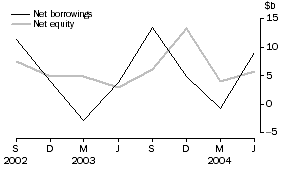
During the June quarter 2004 total liabilities of national public non-financial corporations increased by $6.4b to $92.1b. There was net issue of debt securities of $0.3b and accounts payable decreased by $0.1b. Liabilities of state and local public non-financial corporations increased by $6.8b to $145.0b.
Private non-financial corporations debt to equity ratio
From the end of June 2002 to the end of June 2004 the value of equity on issue increased by $136.8b. The value of debt outstanding rose $47.2b during the period. During the quarter, private non-financial corporation debt increased by $10.5b, while equities on issue increased by $23.7b. Over the June quarter 2004, the original debt to equity ratio fell from 0.77 to 0.76 and the adjusted ratio remained unchanged at 1.08. The adjusted ratio reflects the removal of price change from the original series.
DEBT TO EQUITY RATIO - JUNE 1995 BASE
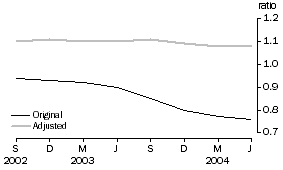
FINANCIAL CORPORATIONS
Summary
During the June quarter 2004, financial corporations issued $36.2b liabilities on a consolidated basis. Net issuers of liabilities were: banks $23.1b, pension funds $17.1b, financial intermediaries n.e.c. $10b and other depository corporations $1.9b. Net redeemers were: central borrowing authorities $4.3b, the central bank $1.2b and other insurance corporations $0.2b.
Banks
During the quarter, banks increased their currency and deposits liabilities by $20.5b. They had net issuance in bonds of $19b and bills of exchange of $1.4b. They reduced their liabilities in derivatives by $11.6b, and loans and placements by $5.6b. They also decreased issuance of one name paper $0.2b and other accounts payable $0.5b.
Banks had an increase of $35.5b in financial assets during the quarter. Banks loaned a net $34.4b, with increases in loans to households $24.5b, and private non-financial corporations of $8.4b. They also increased their holdings of currency and deposits by $0.4b, bills of exchange by $1.7b, one name paper $0.9b and bonds $3.6b. They reduced their holdings of equities by $0.8b and derivatives $6.5b.
Other depository corporations
Funding of other depository corporations increased by $1.9b during the June quarter 2004 following net issuance of bonds of $3.7b, and currency and deposits of $3.2b. These increases were partially offset by net redemptions in one name paper of $3.4b, and net settlements of derivatives in a net liability position of $3.2b. Financial assets decreased by $3.0b, through net settlements of derivatives in a net asset position of $7.3b. This reduction was offset somewhat by an increase in currency and deposits of $3.1b.
Life insurance corporations
At 30 June 2004, the financial assets of life insurance corporations stood at $193.1b, an increase of $5.5b from the previous quarter with net transactions of $0.1b and valuation increases of $5.4b. During the quarter there were net purchases of bonds of $1.7b, one name paper of $0.4b,loans and placements of $0.2b and currency and deposits of $0.2b. There were net sales of equity of $1.9b and bills of exchange of $0.4b. Pension fund claims against the reserves of life offices increased by $4.7b following net transactions of $0.2b and valuation increases of $4.5b. Other claims against the reserves of life offices decreased by $0.8b following withdrawals of $2.0b and valuation increases of $1.2b.
Pension funds
Net equity in reserves of pension funds was $596.0b at the end of the June quarter 2004, an increase of $25.1b (4%), following net transactions of $16.1b and $9.0b valuation increases during the quarter. Most asset classes experienced increases during the quarter, with transactions in equities of $8.1b, currency and deposits of $3.2b, long term debt securities of $5.0b, loans and placements of $1.1b, other accounts receivable of $1.1b, short term debt securities of $1.0b and net equity of pension funds in life office reserves of $0.2b. During the quarter the Australian government paid $3.0b of claims against them by public sector emplyee superannuation funds.
Other insurance corporations
Net buy-back of listed shares of $0.4b, and net reductions in prepayments of premiums and reserves of $0.2b, were offset to some extent by net issuance of unlisted shares of $0.3b contributing to an overall reduction of liabilities of $0.2b. Transactions in financial assets of other insurance corporations were $0.1b, following net increases in other accounts receivable of $1.5b, and equities of $0.6b. These increases were partially offset by decreases in one name paper of $0.8b, and bonds of $0.8b.
Central borrowing authorities
Total liabilities of central borrowing authorities was $102.6b at the end of the June quarter 2004. The authorities had net redemption in bonds of $0.4b, a net redemption in one name paper of $2.5b and an decrease in loans and placements liabilities of $0.2b.
Financial intermediaries n.e.c.
Financial intermediaries n.e.c. increased their liabilities by $10.0b during the quarter, mainly through an increased issue of bonds ($8.3b) and listed and unlisted shares and other equity ($2.4b). Financial assets increased by $4.9b, mainly through loans to households which increased by $4.2b and purchases of equities issued by private non-financial corporations ($1.5b).
Net flow of currency and deposits to banks
Net transactions in currency and deposit liabilities of banks during the June quarter 2004 were $20.5b. Sectors that increased currency and deposit assets during the quarter included rest of the world $6.3b, households $4.8b, other depository corporations $3.0b and private non-financial corporations $4.2b.
CURRENCY AND DEPOSITS LIABILITIES, BANKS
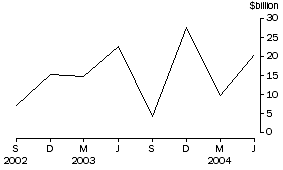
Asset portfolio of life insurance corporations and pension funds at end of quarter
At the end of June quarter 2004 life insurance corporations held $114.3b in shares and other equity (59% of their financial assets), of which $90.5b was in resident companies and $23.7b was in non-resident companies; $40.6b in bonds (21% of their financial assets), of which $36.0 b was in Australian bonds and $4.6b in non-resident bonds; and $18.6b in short term securities (10% of their financial assets).
At the end of June quarter 2004 pension funds held $286.7b in shares and other equity (50% of their financial assets), of which $209.6b was in resident companies and $77.2b was in non-resident companies. They held $134.7b of net equity in life office reserves (24% of their financial assets); and $54.6b in bonds (10% of their financial assets), of which $32.2b were Australian bonds and $22.4b were non-resident bonds.
Financial claims between households, life insurance companies, pension funds and investment managers at end of quarter
At the end of June quarter 2004 households had claims against the reserves of life insurance corporations of $38.2b and pension funds of $596.0b. Pension funds had claims against the reserves of life insurance corporations of $134.7b. Life insurance corporations invested $138.7b of their financial assets through investment managers and pension funds invested $232.2b through investment managers.
Asset portfolio of other insurance corporations at end of quarter
The graph below shows that at the end of June quarter 2004 other insurance corporations held $26.1b in bonds (29% of total financial assets), of which $24.6b were issued domestically. Other insurance corporations also held $23.4b in shares and other equity (26% of total financial assets), of which $19.3b was in resident corporations and $4.1b in non-resident corporations.
OTHER INSURANCE CORPORATIONS, ASSETS
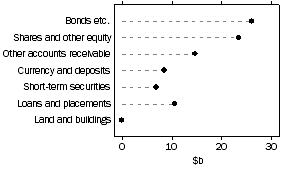
Central borrowing authorities net issue of debt securities
Central borrowing authorities had net redemption of bonds of $0.4b and a net redemption in one name paper of $2.5b in the June quarter 2004.
CENTRAL BORROWING AUTHORITIES, NET ISSUES
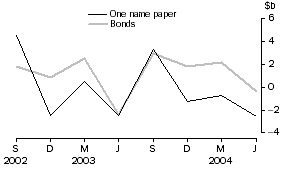
Financial intermediaries n.e.c. net issue of debt securities
During the June quarter 2004 financial intermediaries n.e.c. made a net issuance of bonds of $8.3b and a net issuance of short term paper of $0.4b.
FINANCIAL INTERMEDIARIES N.E.C., NET ISSUES
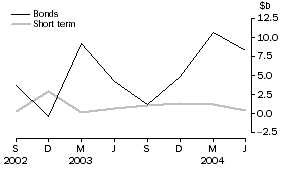
GENERAL GOVERNMENT
Summary
During the June quarter 2004, general government transactions resulted in a net decrease in financial position of $4.5b (see table 33, June quarter 2004). National general government increased its liabilities by $1.2b during the June quarter 2004 and decreased its financial assets by $0.5b to record a net change in financial position of -$1.6b. Assets decreased following a $0.6b fall in cash and deposits and a $0.7b fall in derivatives, offset by a rise in loans and placements of $1.0b. Liabilities increased following a $2.9b rise in other accounts receivable and a $1.8b issue of bonds, mainly offset by a $3.1b repayment of unfunded superannuation claims. At the end of June 2004, national general government had total liabilities of $178.5b and total financial assets of $94.7b.
Transactions in state and local general government financial assets were -$1.9b in the June quarter 2004, while transactions in total liabilities were $0.9b, resulting in a decrease in financial position of $2.8b. At the end of the quarter, state and local general government had total liabilities of $102.0b and total financial assets of $137.2b.
Change in financial position
CHANGE IN FINANCIAL POSITION, GENERAL GOVERNMENT
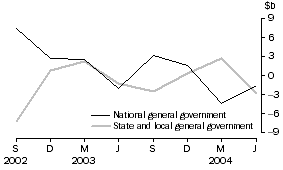
National government issue of debt securities
The accompanying graph illustrates the national general government’s bond issuance, with a net increase of $1.8b in treasury bonds during the quarter.
NATIONAL GENERAL GOVERNMENT, NET ISSUES
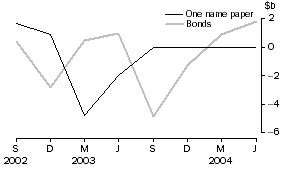
HOUSEHOLDS
Summary
Households borrowed a total of $30.4b during the quarter in the form of loans. Deposit assets increased by $8.1b, of which bank deposits accounted for $4.8b. Net contributions to life insurance and pension fund reserves were $14.1b while net contributions to unfunded superannuation schemes were $1.4b.
Households purchased a net $0.7b in equities during the June quarter 2004, the major contributors being purchases of $2.1b of private non-financial corporation shares and $0.3b of financial intermediaries n.e.c. shares. These were offset by the $0.6b sale of national public non-financial corparation shares and $0.5b sale of both bank and other insurance corporations shares.
At the close of the quarter, households' stock of financial assets was $1,483.6b. This was up $40.6b from the revised previous quarter number, following net transactions of $23.1b and valuation increases of $17.5b. Major asset holdings were net equity in reserves of life insurance corporations and pension funds of $634.2b, currency and deposits of $355.3b, equities of $262.2b, and unfunded superannuation claims of $147.3b.
Household net borrowing and debt to liquid asset ratio
Of the net $30.4b borrowed by households, bank loans accounted for $24.5b. Of the bank loans, $10.1b was borrowed for owner occupied housing and $8.3b for investment housing. This borrowing raised household bank loan liabilities to $568.2b and total household liabilities to $797.5b at the end of the quarter.
The graph below illustrates that the debt to liquid assets ratio at 30 June 2004 was at 122.8%, an increase of 2% from the revised March quarter ratio. During the June quarter the ratio was influenced by an overall increase of 4% in household borrowing for the quarter and a 2% increase in liquid assets, of which the major contributors were deposits and equities.
HOUSEHOLD DEBT/LIQUID ASSETS RATIO
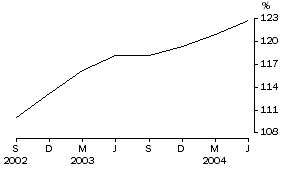
Insurance and pension claims
During the June quarter 2004 households' net equity in reserves of pension funds increased $25.1b, made up of $16.1b net contributions and $9.0b valuation increases, bringing household net equity in pension funds to $596.0b. Net equity in reserves of life insurance corporations decreased by $0.8b, made up of $2.0b net withdrawals and $1.2b valuation increases, bringing the household net equity in life insurance to $38.2b. Households' unfunded superannuation claims increased by $1.4b during the quarter. Prepayments of premiums and claims against reserves in general insurance corporations decreased by $0.1b.
REST OF THE WORLD
Summary
Non-residents invested a net $19.8b in Australian financial assets during the June quarter 2004. There were purchases of bonds, $29.0b (of which $16.6b was issued by banks and $5.2 by financial intermediaries n.e.c.), purchases of equities, $4.9b (of which $3.9b was issued by private non-financial corporations) and increases in their holdings of currency and deposits, $6.5b. These were offset by non-residents reducing their loans and placements ($8.7b), holdings of derivative contracts ($7.0b) and one name paper ($6.7b). Overall, the value of Australian financial assets held by non-residents at the end of the quarter was up $46.9b from the March quarter, after taking into account $27.1b valuation increases.
Australian residents purchased foreign financial assets worth $8.1b during the June quarter 2004. There were resident purchases of equities ($6.5b) and bonds issued in Australia ($1.8b), residents made loans and placements of $2.4b, deposited $1.5b and purchased one name paper of $0.4b. These were offset by residents reducing their holdings of derivative contracts by $6.6b. Overall, the total value of foreign assets held by Australian residents increased to $583.3b at the end of the quarter.
Net purchases of equities
The accompanying graph shows that during the June quarter 2004 non-residents purchased a net $4.9b in equities, a decrease of $2.4b compared with the March quarter 2004.
NET PURCHASES OF EQUITIES BY NON-RESIDENTS
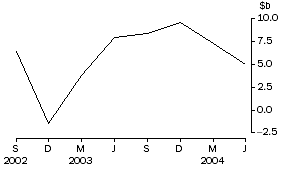
Net purchases of bonds
The accompanying graph shows that non-residents purchased $29.0b of Australian bonds during the June quarter 2004, an increase of $3.1b compared with the March quarter 2004.
NET PURCHASES OF BONDS BY NON-RESIDENTS
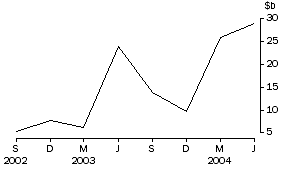
 Print Page
Print Page
 Print All
Print All